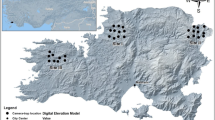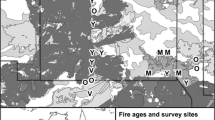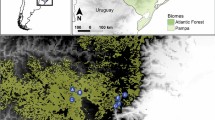Abstract
Invasive non-native grasses can greatly alter habitat structure. Land managers use fire to reduce invasive grass infestations, a strategy which is intended, at least in part, to reduce the impact of wildfires on fauna. The response of fauna to fire in invasive grass environments may be complex. To examine the responses of fauna to fire and invasive grass we compared mammal richness and abundance in a group of 24 replicated sites in north Queensland, Australia. Our sites were characterised by native kangaroo grass, native black spear grass, or invasive, non-native grader grass, and we surveyed them at three times in relation to fire. First, when they had remained unburnt for 2 years (pre-burnt), just after burning (post-burnt), and up to 15 months after burning (revegetated, i.e., the grass had naturally regrown). Therein, we monitored vegetation structure and mammal richness, abundance and assemblage composition. The lowest overall mammal abundances occurred in sites revegetated after fire (40–55 % lower abundances in revegetated compared to pre-burnt sites), but rufous bettongs (Aepyprymnus rufescens) and tropical short-tailed mice (Leggadina lakedownensis) increased in abundance following fire. Abundance of eastern chestnut mice (Pseudomys gracilicaudatus) and common planigales (Planigale maculata) decreased after fire, but returned with returning grass cover. We detected a gradual decline in northern brown bandicoots (Isoodon macrourus) over the course of the study, with no recovery. We found no evidence that mammals showed stronger responses in invasive than native grasses after fire. Mammal responses to fire were distinctive, some species were more abundant following fire, some less, and some species returned to their prior abundances. Thus, in tropical savannahs, a naturally fire-prone system, overall mammal abundance, but not richness, decreased after fires, in both native and non-native grass, but the responses of individual species varied greatly. Decisions to burn invasive grasses for biodiversity conservation should include an awareness of the likelihood of enhancing certain species while discouraging others.



Similar content being viewed by others
References
Abom R, Schwarzkopf L (2016) Short-term responses of reptile assemblages to fire in native and weedy tropical savannah. Global Ecol Conserv 6:58–66
Abom R, Vogler W, Schwarzkopf L (2015) Mechanisms of the impact of a weed (grader grass, Themeda quadrivalvis) on reptile assemblage structure in a tropical savannah. Biol Conserv 191:75–82
Alba C, Skálová H, McGregor KF, D’Antonio C, Pyšek P (2015) Native and exotic plant species respond differently to wildfire and prescribed fire as revealed by meta-analysis. J Veg Sci 26:102–113
Andersen AN, Cook GD, Corbett LK, Douglas MM, Eager RW, Russell-Smith J, Setterfield SA, Williams RJ, Woinarski JCZ (2005) Fire frequency and biodiversity conservation in Australian tropical savannas: implications from the Kapalga fire experiment. Austral Ecol 30:155–167
Atkinson A, Atkinson V, (1995) Undara volcano and its lava tubes: a geological wonder of Australia in Undara volcanic national park, North Queensland. Brisbane Queensland by Vernon and Anne Atkinson
Barlow J, Peres CA (2004) Ecological responses to El Niño–induced surface fires in central Brazilian Amazonia: management implications for flammable tropical forests. Philos Trans R Soc B 359:367–380
Barton K (2013) MuMIn: Multi-model inference. R package version 1.9.0. http://CRAN.R-project.org/package=MuMIn
Bates D, Maechler M, Bolker B (2013) lme4: Linear mixed-effects models using S4 classes, R package, version 0.999999-0, 2012. https://github.com/lme4/lme4/, http://lme4.r-forge.r-project.org/
Bock CE, Jones ZF, Kennedy LJ, Bock JH (2011) Response of rodents to wildfire and livestock grazing in an Arizona desert grassland. Am Midl Nat 166:126–138
Breed B, Ford F (2007) Native mice and rats. CSIRO Publishing, Collingwood, pp 115–124
Burgess EE, Moss P, Haseler M, Maron M (2014) The influence of a variable fire regime on woodland structure and composition. Int J Wildland Fire. doi:10.1071/WF14052
Burnham K, Anderson D (2002) Model selection and multimodel inference: a practical information-theoretic approach, 2nd edn. Springer, New York
Clark BK, Kaufman DW (1990) Short-term responses of small mammals to experimental fire in tallgrass prairie. Can J Zool 68:2450–2454
D’Antonio CM, Vitousek PM (1992) Biological invasions by exotic grasses, the grass/fire cycle, and global change. Annu Rev Ecol Syst 23:63–87
D’Souza JB, Whittington A, Dickman CR, Leung LK-P (2013) Perfect storm: demographic responses of an irruptive desert mammal to prescribed burns following flooding rain. Austral Ecol 38:765–776
Foxcroft LC, Richardson DM, Rejmánek M, Pyšek P (2010) Alien plant invasions in tropical and sub-tropical savannas: patterns, processes and prospects. Biol Invasions 12:3913–3933
Francl KE, Small CJ (2013) Temporal changes and prescribed-fire effects on vegetation and small-mammal communities in central Appalachian forest, creek, and field habitats. Southeast Nat 12:11–26
Friend GR (1990) Breeding and population dynamics of Isoodon macrourus (Marsupialia: Peramelidae): studies from the wet–dry tropics of northern Australia. In: Seebeck JH, Brown PR, Wallis RL, Kemper CM (eds) Bandicoots and bilbies. Surrey Beatty and Sons, Sydney, pp 357–365
Griffiths AD, Brook BW (2014) Effect of fire on small mammals: a systematic review. Int J Wildland Fire 23:1034–1043
Griffiths AD, Garnett ST, Brook BW (2015) Fire frequency matters more than fire size: testing the pyrodiversity–biodiversity paradigm for at-risk small mammals in an Australian tropical savannah. Biol Conserv 186:337–346
Haslem A, Kelly LT, Nimmo DG, Watson SJ, Kenny SA, Taylor RS, Avitabile SC, Callister KE, Spence-Bailey LM, Clarke MF, Bennett AF (2011) Habitat or fuel? Implications of long-term, post-fire dynamics for the development of key resources for fauna and fire. J Appl Ecol 48:247–256
Johnson C (2006) Australia’s mammal extinctions: a 50,000 year history. Cambridge University Press, Port Melbourne
Keir AF, Vogler WD (2006) A review of current knowledge of the weedy species Themeda quadrivalvis (grader grass). Trop Grassl 40:193–201
Kelly LT, Bennett AF, Clarke MF, McCarthy MA (2014) Optimal fire histories for biodiversity conservation. Conserv Biol 2:473–481
Kirchner BN, Green NS, Sergeant DA, Mink JN (2011) Responses of small mammals and vegetation to a prescribed burn in a tallgrass Blackland prairie. Am Midl Nat 166:112–125
Kutt AS, Kemp JE (2005) Distribution, habitat and conservation status of Leggadina lakedownensis (Rodentia: Muridae) in Queensland. Austral Zool 33:258–264
Lenth RV (2013) lsmeans: Least-squares means. R package version 1.10–4. http://CRAN.R-project.org/package=lsmeans
Lindsay EA, Cunningham SA (2012) Effects of exotic grass invasion on spatial heterogeneity in the ground-layer of grassy woodlands. Biol Invasions 14:203–213
Litt AR, Steidl RJ (2011) Interactive effects of fire and nonnative plants on small mammals in grasslands. Wildl Monogr 176:1–31
McCune B, Mefford MJ (1999) Multivariate analysis of ecological data, version 5. MjM Software Design, Gleneden Beach
Mendonça AF, Armond T, Camargo ACL, Camargo NF, Ribeiro JF, Zangrandi PL, Vieira EM (2015) Effects of an extensive fire on arboreal small mammal populations in a neotropical savanna woodland. J Mammal 96:368–379
Menkhorst P, Knight F (2004) A field guide to the mammals of Australia, 2nd edn. Oxford University Press, Victoria
Moro D, Morris K (2000) Movements and refugia of Lakeland Downs short-tailed mice, Leggadina lakedownensis, and house mice, Mus domesticus, on Thevenard Island, Western Australia. Wildl Res 27:11–20
Pardon GL, Brook BW, Griffiths AD, Braithwaite RW (2003) Determinants of survival for the northern brown bandicoot under a landscape-scale fire experiment. J Anim Ecol 72:106–115
Parr CL, Andersen AN (2006) Patch mosaic burning for biodiversity conservation: a critique of the pyrodiversity paradigm. Conserv Biol 6:1610–1619
Pope LC, Blair D, Johnson CN (2005) Dispersal and population structure of the rufous bettong, Aepyprymnus rufescens (Marsupialia: Potoroidae). Austral Ecol 30:572–580
Price OF, Russell-Smith J, Watt F (2012) The influence of prescribed fire on the extent of wildfire in savanna landscapes of western Arnhem Land, Australia. Int J Wildland Fire 21:297–305
Queensland Fire and Rescue Authority Act (1990) www.legislation.qld.gov.au/LEGISLTN/CURRENT/F/FireARescSeA90.pdf
R core team (2012) R: a language and environment for statistical computing R foundation for statistical computing Vienna
Russel-Smith J, Edwards AC, Price OF (2012) Simplifying the savannah: the trajectory of fire-sensitive vegetation mosaics in northern Australia. J Biogeogr 39:1303–1317
Setterfield SA, Rossiter-Rachor NA, Hutley LB, Douglas MM, Williams RJ (2010) Turning up the heat: the impacts of Andropogon gayanus (gamba grass) invasion on fire behaviour in northern Australian savannas. Divers Distrib 16:854–861
Smith AL, Bull MC, Driscoll DA (2013) Successional specialization in a reptile community cautions against widespread planned burning and complete fire suppression. J Appl Ecol 50:1178–1186
Tng DYP, Goosem S, Jordan GJ, Bowman DMJS (2014) Letting giants be—rethinking active fire management of old-growth eucalypt forest in the Australian tropics. J Appl Ecol 51:555–559
Vernes K, Pope LC (2001) Stability of nest range, home range and movement of the northern bettong (Bettongia tropica) following moderate-intensity fire a tropical woodland, north-eastern Queensland. Wildl Res 28:141–150
Vieira EM (1999) Small mammal communities and fire in the Brazilian Cerrado. J Zool 249:75–81
Vogler WD, Owen NA (2008) Grader grass (Themeda quadrivalvis): changing savannah ecosystems. In: Proceedings of the 16th Australian weeds conference
Woinarski JCZ, Risler J, Kean L (2004) Response of vegetation and vertebrate fauna to 23 years of fire exclusion in a tropical Eucalyptus open forest, Northern Territory, Australia. Austral Ecol 29:156–176
Acknowledgments
This project was partly funded by Biosecurity Queensland, a business group of the Department of Agriculture, Fisheries and Forestry, and the Northern Gulf Resource Management Group. We would also like to extend our gratitude to Undara National Park rangers and especially to Nick Smith and family for extensive in kind support. Environmental Protection Agency Permit WITK05527908, and Ethics approval A1354.
Author information
Authors and Affiliations
Corresponding author
Electronic supplementary material
Below is the link to the electronic supplementary material.
Rights and permissions
About this article
Cite this article
Abom, R., Parsons, S.A. & Schwarzkopf, L. Complex mammal species responses to fire in a native tropical savannah invaded by non-native grader grass (Themeda quadrivalvis). Biol Invasions 18, 3319–3332 (2016). https://doi.org/10.1007/s10530-016-1224-0
Received:
Accepted:
Published:
Issue Date:
DOI: https://doi.org/10.1007/s10530-016-1224-0




